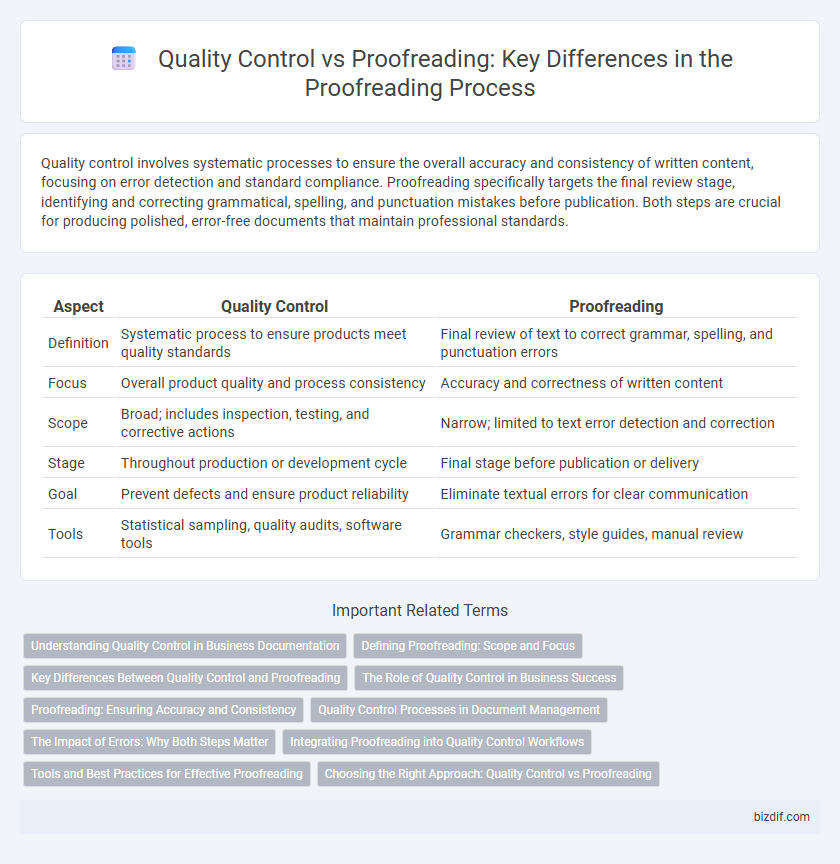Quality control involves systematic processes to ensure the overall accuracy and consistency of written content, focusing on error detection and standard compliance. Proofreading specifically targets the final review stage, identifying and correcting grammatical, spelling, and punctuation mistakes before publication. Both steps are crucial for producing polished, error-free documents that maintain professional standards.
Table of Comparison
| Aspect | Quality Control | Proofreading |
|---|---|---|
| Definition | Systematic process to ensure products meet quality standards | Final review of text to correct grammar, spelling, and punctuation errors |
| Focus | Overall product quality and process consistency | Accuracy and correctness of written content |
| Scope | Broad; includes inspection, testing, and corrective actions | Narrow; limited to text error detection and correction |
| Stage | Throughout production or development cycle | Final stage before publication or delivery |
| Goal | Prevent defects and ensure product reliability | Eliminate textual errors for clear communication |
| Tools | Statistical sampling, quality audits, software tools | Grammar checkers, style guides, manual review |
Understanding Quality Control in Business Documentation
Quality control in business documentation involves systematic processes to ensure accuracy, consistency, and compliance with organizational standards before final approval. It encompasses thorough reviews, verification of data, and adherence to formatting guidelines, reducing errors and improving overall document reliability. Effective quality control enhances professional communication and supports regulatory requirements across various industries.
Defining Proofreading: Scope and Focus
Proofreading involves meticulously reviewing a final draft to identify and correct surface errors such as typos, grammar mistakes, punctuation issues, and formatting inconsistencies. The scope of proofreading is narrower than quality control, focusing primarily on linguistic accuracy and presentation rather than overall content or structural coherence. Proofreading serves as the last step before publication or submission, ensuring that the text meets the highest standards of clarity and correctness.
Key Differences Between Quality Control and Proofreading
Quality control encompasses a comprehensive process that ensures the overall standard of a product or service by evaluating multiple factors including accuracy, consistency, and compliance with specifications. Proofreading specifically involves reviewing text to identify and correct grammatical, spelling, and punctuation errors, focusing solely on the accuracy of written content. The key difference lies in quality control's broader scope targeting the entire production process, while proofreading serves as a targeted final check on textual precision.
The Role of Quality Control in Business Success
Quality control ensures consistent product excellence by systematically identifying and addressing defects before market release, which directly enhances customer satisfaction and brand reputation. Proofreading, as a specific quality control step, focuses on eliminating textual errors that could undermine professionalism and clarity in communication materials. Effective quality control protocols integrate comprehensive proofreading to maintain overall operational standards and drive sustained business success.
Proofreading: Ensuring Accuracy and Consistency
Proofreading involves meticulously reviewing text to eliminate errors in grammar, punctuation, and spelling, ensuring accuracy and consistency throughout the document. It focuses on refining language clarity and maintaining stylistic coherence to enhance overall readability. By catching subtle mistakes missed during initial editing, proofreading guarantees polished and professional final content.
Quality Control Processes in Document Management
Quality Control processes in document management ensure the accuracy, consistency, and compliance of documents by systematically reviewing and verifying content against predefined standards. Unlike proofreading, which primarily focuses on correcting grammar, spelling, and punctuation errors, Quality Control encompasses a broader scope including format validation, data integrity checks, and adherence to regulatory requirements. Implementing robust Quality Control protocols enhances document reliability, reduces errors, and supports overall organizational efficiency in information management.
The Impact of Errors: Why Both Steps Matter
Quality control and proofreading both play critical roles in minimizing errors that can damage credibility and customer trust. Proofreading targets grammatical, spelling, and typographical mistakes to ensure clarity, while quality control focuses on broader consistency, accuracy, and compliance with standards. Combining these steps significantly reduces the risk of errors that affect brand reputation and user experience.
Integrating Proofreading into Quality Control Workflows
Integrating proofreading into quality control workflows enhances the accuracy and consistency of final deliverables by systematically identifying and correcting textual errors early in the process. Utilizing specialized proofreading tools and trained professionals within quality control teams ensures that language quality standards align with overall product specifications. This integration reduces rework, accelerates project timelines, and supports clear, error-free communication across digital and print media.
Tools and Best Practices for Effective Proofreading
Effective proofreading relies on specialized tools such as Grammarly, Hemingway Editor, and ProWritingAid to detect grammar errors, punctuation mistakes, and style inconsistencies. Best practices include reading texts aloud, utilizing multiple tool checks, and maintaining context awareness to ensure accuracy and clarity. Combining automated software with manual review enhances quality control, producing polished, error-free content.
Choosing the Right Approach: Quality Control vs Proofreading
Choosing the right approach between quality control and proofreading depends on the scope and goals of your project. Quality control encompasses a broader review process, including multiple checks for accuracy, formatting, and consistency, while proofreading specifically targets surface-level errors like typos and grammar mistakes. Opt for quality control for comprehensive assurance and proofreading for final polish.
Quality Control vs Proofreading Infographic

 bizdif.com
bizdif.com